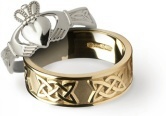Blog Categories
Blog CategoriesMatrimoni e ruolo dei gioielli celtici
Weddings are the perfect opportunity to introduce Celtic jewelry into the ceremony and you don’t have to be Irish or have Irish connections to enjoy incorporating the beauty of the designs.
Based on the ethereal design work created by the ancient Celts of Europe, Britain, Scotland and Ireland, Celtic designs were typically characterized by complex patterns and two dimensional decorations, based on motifs and symbols.
Celtic jewelry is mostly instantly recognisable today with the use of woven lines, circles, spirals and knots. There is so much symbolism involved in the designs. The much loved Trinity knot for example - also known as the Triskele - is a triple spiral that holds several meanings from the cycle of life, death and rebirth to the land, sky and sea.
It’s obvious why Celtic and Irish jewelry is the perfect fit when it comes to weddings. This is jewelry with deep, deep meaning and layers of history, promise and stories. It’s the perfect choice for any ceremony, as there are so many ways that you can bring in the stories and traditions through jewelry. These beautiful pieces can be worn for a lifetime.
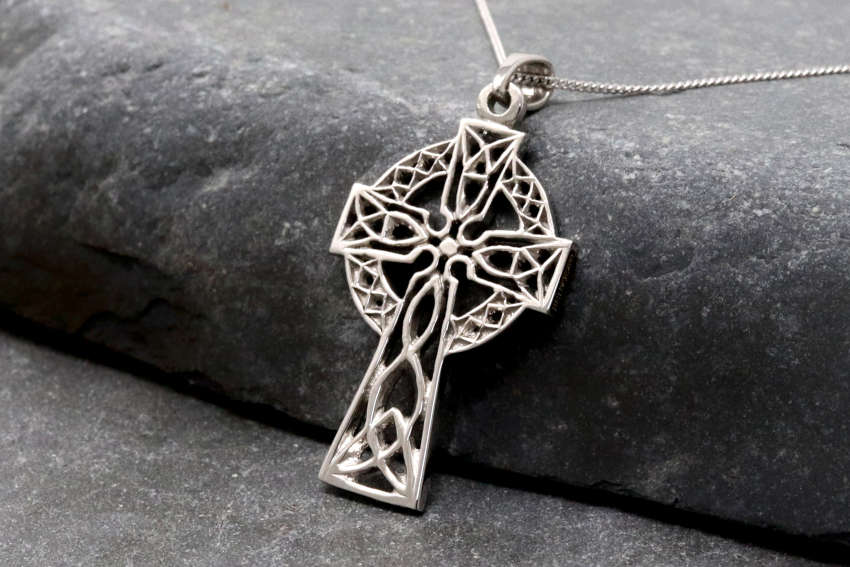 |
| Filigree Silver Celtic Cross |
Claddagh, Trinity and Celtic Cross
Say the word ‘Celtic jewelry’ and Celtic crosses, the Claddagh Ring or Trinity Knot will most likely come to mind. While many will recognise these immediately by sight - not everyone knows the hidden meanings behind each of these designs and how they can be incorporated into weddings.
When it comes to the official classification, archaeologists and historians use the term ‘Celtic’ to refer to roughly 1000 BC and Iron Age European culture, which ended around the time of the Roman conquest.
Specifically, most of the recognisable Celtic art is from the La Tène period (from fifth to first centuries B.C.). This is named after the archaeological site in Switzerland where thousands of artefacts from these centuries were discovered, after a lake’s water level dropped in 1857 to reveal amazing treasures.
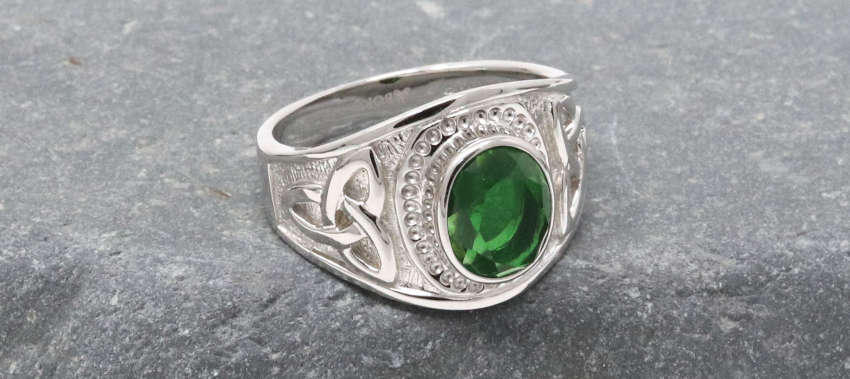 |
| Celtic Fraternity Ring |
Gold, Silver and Bronze
The La Tène culture proliferated throughout eastern and western Europe, reaching as far as Britain and Ireland. Recognisable by intricate spirals and geometric designs, the pieces were often made in gold, silver, and bronze. The tripartite spiral of the triskele was used frequently.
With the spread of early Christianity and after the Roman conquest of Britain and Ireland, the production of Insular art began. This comes from the Latin word for “island”—insula. Unlike La Tène art, the styles produced in Ireland remained different to that of mainland western Europe. Insular art brought many of the geometric designs from La Tène art into its motifs, but then they began to appear in devotional illustrations and the construction of crosses, as Ireland was quickly becoming a Christian country.
Work soon began on the Book of Kells, the most famous illuminated manuscript in European medieval history. Here, in this must-visit treasure in Trinity College, the intricate designs feature elaborate Celtic knots, swirls, and spirals, often surrounding illustrations of monks, animals, and plants. A different page is shown each day to visitors.
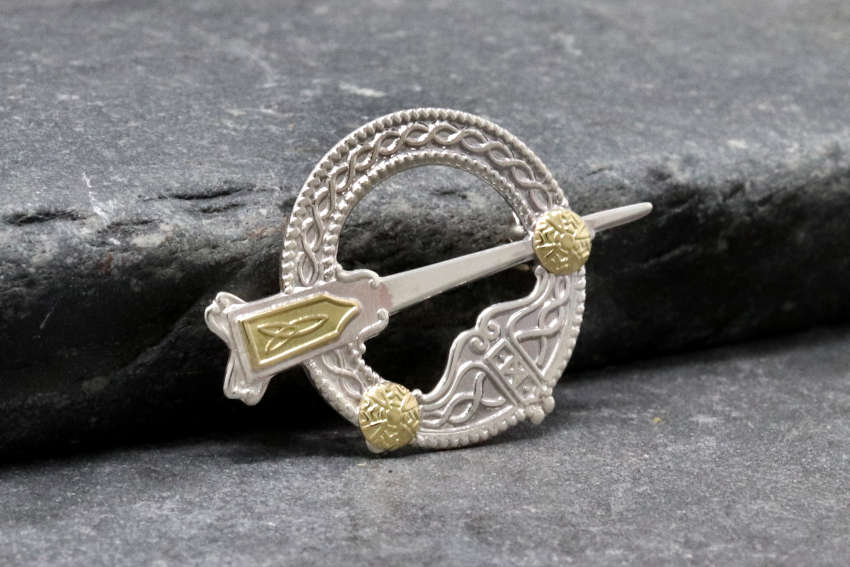 |
| Silver with 18k Gold Tara Brooch |
Treasure at Tara
The Tara Brooch, which is a beautiful gift for bridesmaids or members of the wedding party as a replica, is one of the most famed examples of jewelry from the Insular period. Though it was named after the Hill of Tara, the ancient seat of the High Kings of Ireland, it was actually found, in 1850, miles away in the seaside town of Bettystown, County Meath. It’s likely that the seller named it after the Hill of Tara to increase its value as at that time in the mid-19th century, the Celtic Revival had heightened the interest in artefacts from ancient and medieval Ireland.
The brooch is traced back to roughly the eighth century, as it is made of silver, both cast and gilt, gold filigree, glass, enamel, and amber. It’s decorated on both front and back with delicate animals and intricate scroll designs. Its shape is pseudo-penannular, which means it included a circular shape and a long pin and was meant to be used as a clothing fastener. The National Museum of Ireland, where the brooch resides says: “The Tara Brooch can be considered to represent the pinnacle of early medieval Irish metalworkers’ achievement. Each individual element of decoration is executed perfectly and the range of technique represented on such a small object is astounding.”
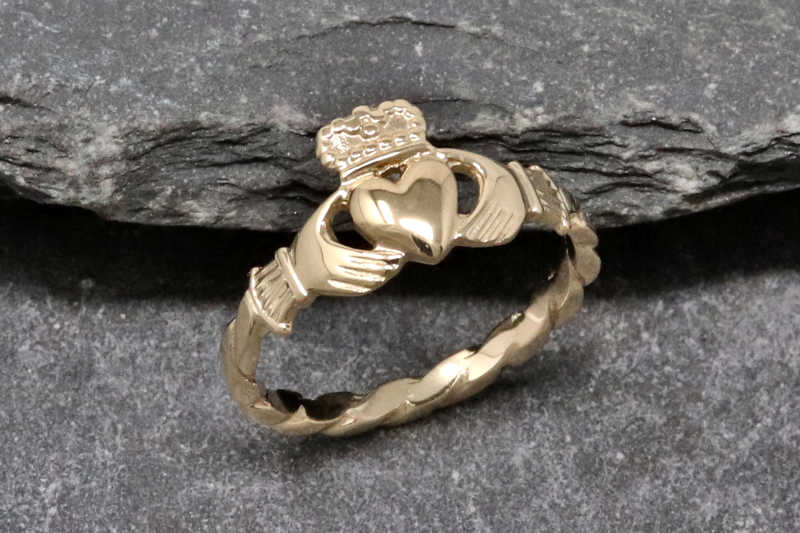 |
| Twist Shank Gold Claddagh Ring |
Classic Claddagh
The Claddagh is perfect for a wedding or engagement ring or to be brought in to the embroidery or design of wedding stationery. The ring is part of a category of rings called fede rings, which take their name from the Italian phrase mani in fede, which means “hands joined in faith” or “hands joined in loyalty.” This style of ring features clasped hands and had been used as a symbol of commitment in Europe since Roman times.
The Claddagh ring, specifically, adds a heart, symbolizing love, and a crown, symbolizing loyalty, to the clasped hands design. Originating from the fishing village of Claddagh in County Galway, the way it’s worn after a wedding or engagement has huge significance.
A ring worn on the right hand ring finger with the heart facing the fingertips indicates that the wearer is single and ready for love. On the right ring finger with the crown facing out, the wearer is in a relationship, but may not be fully committed. Once engaged, the wearer moves the ring to their left hand, and wears it with the heart facing out. After marriage, the wearer turns the ring so that the crown faces out.
Because of these customs, Claddagh rings are quite frequently given as promise, engagement, or wedding rings, though they can often also be handed down from mother to daughter.
Whether you want to celebrate your Irish or Celtic heritage and display it with pride or you just find Celtic designs beautiful, Celtic jewelry can be worn in so many different ways when it comes to making a big impact at weddings no matter where they are in the world.
